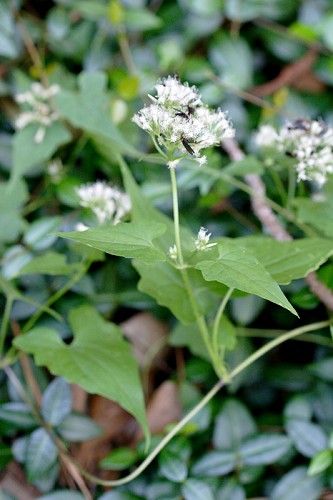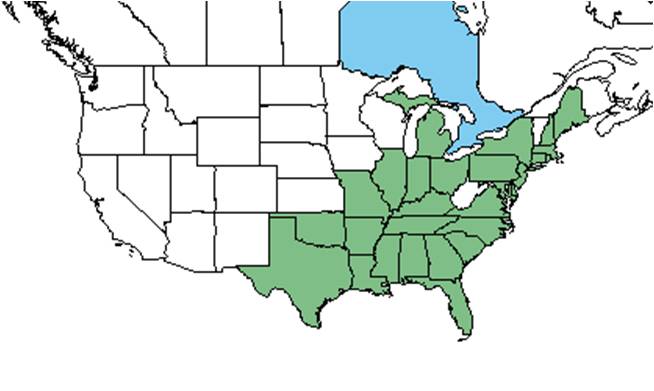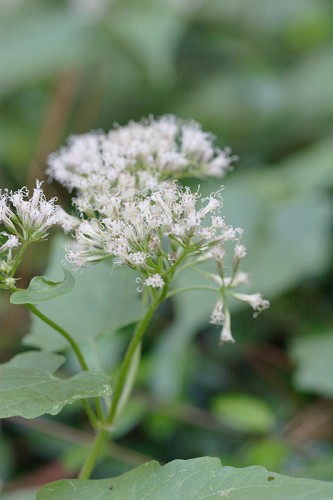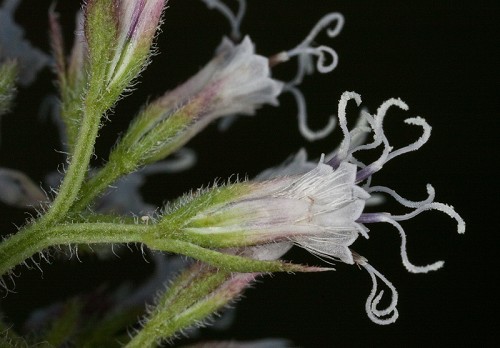Difference between revisions of "Mikania scandens"
(→Taxonomic notes) |
(→Description) |
||
| (2 intermediate revisions by the same user not shown) | |||
| Line 27: | Line 27: | ||
A description of ''Mikania scandens'' is provided in [http://efloras.org/florataxon.aspx?flora_id=1&taxon_id=220008598 The Flora of North America]. | A description of ''Mikania scandens'' is provided in [http://efloras.org/florataxon.aspx?flora_id=1&taxon_id=220008598 The Flora of North America]. | ||
| − | To distinguish ''M. scandens'' from ''M. cordifolia'', look for an involucre that is 4-5.5 mm high; achenes that are 1.5-2.5 mm long, pubescent stems and leaves, and puberulant or nearly smooth involucres.<ref name= | + | To distinguish ''M. scandens'' from ''M. cordifolia'', look for an involucre that is 4-5.5 mm high; achenes that are 1.5-2.5 mm long, pubescent stems and leaves, and puberulant or nearly smooth involucres.<ref name=weakley/> |
| + | |||
==Distribution== | ==Distribution== | ||
| − | ''M. scadens'' ranges from Maine and southern Ontario to southern Florida and east Texas. It also extends into the tropics.<ref name= | + | ''M. scadens'' ranges from Maine and southern Ontario to southern Florida and east Texas. It also extends into the tropics.<ref name=weakley/> |
| + | |||
==Ecology== | ==Ecology== | ||
===Habitat=== <!--Natural communities, human disturbed habitats, topography, hydrology, soils, light, fire regime requirements for removal of competition, etc.--> | ===Habitat=== <!--Natural communities, human disturbed habitats, topography, hydrology, soils, light, fire regime requirements for removal of competition, etc.--> | ||
| − | ''M. scandens'' has been found in glade and hammock borders, cypress swamps, pinewoods, slash pinelands, compacted limerock, marshes, wet thickets, seepages, and canal banks.<ref name= | + | ''M. scandens'' has been found in glade and hammock borders, cypress swamps, pinewoods, slash pinelands, compacted limerock, marshes, wet thickets, seepages, and canal banks.<ref name=weakley/> <ref name="FSU"> Florida State University Herbarium Database. URL: http://herbarium.bio.fsu.edu. Last accessed: June 2021. Collectors: C. Barilotti, Jane Brockmann, J. Ferborgh, Robert K. Godfrey, Robert Kral, O. Lakela, and Richard S. Mitchell, and Victoria I. Sullivan. States and counties: Florida: Collier, Dade, Monroe, Palm Beach.</ref> It is also found in disturbed areas like roadsides.<ref name="FSU"/> Associated species: ''Sophora, Coccoloba'', and ''Suriana''.<ref name="FSU"/> |
===Phenology=== <!--Timing off flowering, fruiting, seed dispersal, and environmental triggers. Cite PanFlora website if appropriate: http://www.gilnelson.com/PanFlora/ --> | ===Phenology=== <!--Timing off flowering, fruiting, seed dispersal, and environmental triggers. Cite PanFlora website if appropriate: http://www.gilnelson.com/PanFlora/ --> | ||
Latest revision as of 20:08, 15 June 2023
| Mikania scandens | |
|---|---|

| |
| Photo by John R. Gwaltney, Southeastern Flora.com | |
| Scientific classification | |
| Kingdom: | Plantae |
| Division: | Magnoliophyta - Flowering plants |
| Class: | Magnoliopsida – Dicotyledons |
| Order: | Asterales |
| Family: | Asteraceae ⁄ Compositae |
| Genus: | Mikania |
| Species: | M. scandens |
| Binomial name | |
| Mikania scandens (L.) Willd. | |

| |
| Natural range of Mikania scandens from USDA NRCS Plants Database. | |
Common name: climbing hempvine, climbing hempweed[1]
Contents
Taxonomic notes
Synonyms: none[1]
Varieties: Mikania scandens var. pubescens (Nuttall) Torrey & A. Gray; Mikania scandens var. scandens[1]
Description
A description of Mikania scandens is provided in The Flora of North America.
To distinguish M. scandens from M. cordifolia, look for an involucre that is 4-5.5 mm high; achenes that are 1.5-2.5 mm long, pubescent stems and leaves, and puberulant or nearly smooth involucres.[1]
Distribution
M. scadens ranges from Maine and southern Ontario to southern Florida and east Texas. It also extends into the tropics.[1]
Ecology
Habitat
M. scandens has been found in glade and hammock borders, cypress swamps, pinewoods, slash pinelands, compacted limerock, marshes, wet thickets, seepages, and canal banks.[1] [2] It is also found in disturbed areas like roadsides.[2] Associated species: Sophora, Coccoloba, and Suriana.[2]
Phenology
M. scandens flowers from January to October and has been found fruiting in every month of the year.[3][4]
Fire ecology
Mikania scandens persists in frequently burned pine communities. A study on Long Pine Key in Everglades National Park found M. scandens to not vary in phenology or degree of flowering or fruiting comparing plots burned one year, two years, six years, or seven years prior.[5] Populations on the Wade Tract in south Georgia have been known to persist through repeated annual burning.[6]
Herbivory and toxicology
Mikania scandens has been observed at the Archbold Biological Station to host wasps from the Vespidae family such as Pachodynerus nasidens, Parancistrocerus fulvipes rufovestris, and P. salcularis rufulus.[7] Additionally, M. scandens has been observed to host flies such as Plecia nearctica (family Bibionidae), leafcutter bees such as Megachile xylocopoides (family Megachilidae), and plant bugs such as Lygus lineolaris (family Miridae).[8]
Conservation, cultivation, and restoration
Cultural use
Photo Gallery
Flower of Mikania scandens Photo by John R. Gwaltney, Southeastern Flora.com
Close flower view of Mikania scandens Photo by John R. Gwaltney, Southeastern Flora.com
References and notes
- ↑ 1.0 1.1 1.2 1.3 1.4 1.5 Weakley, A.S. 2020. Flora of the Southeastern United States. Edition of 20 October 2020. University of North Carolina at Chapel Hill, Chapel Hill, North Carolina.
- ↑ 2.0 2.1 2.2 Florida State University Herbarium Database. URL: http://herbarium.bio.fsu.edu. Last accessed: June 2021. Collectors: C. Barilotti, Jane Brockmann, J. Ferborgh, Robert K. Godfrey, Robert Kral, O. Lakela, and Richard S. Mitchell, and Victoria I. Sullivan. States and counties: Florida: Collier, Dade, Monroe, Palm Beach.
- ↑ [www.gilnelson.com/PanFlora/ PanFlora Plant Database], Gil Nelson. Last accessed:2/12/2020
- ↑ Gunderson, L., D. Taylor and J. Craig 1983. Report SFRC-83/04 Fire effects on flowering and fruiting patterns of understory plants in pinelands of EVER. Everglades National Park, South Florida Research Center, Homestead, Florida, 36 pg.
- ↑ Gunderson, L., D. Taylor and J. Craig 1983. Report SFRC-83/04 Fire effects on flowering and fruiting patterns of understory plants in pinelands of EVER. Everglades National Park, South Florida Research Center, Homestead, Florida, 36 pg.
- ↑ Platt, W.J., R. Carter, G. Nelson, W. Baker, S. Hermann, J. Kane, L. Anderson, M. Smith, K. Robertson. 2021. Unpublished species list of Wade Tract old-growth longleaf pine savanna, Thomasville, Georgia.
- ↑ Deyrup, M.A. and N.D. 2015. Database of observations of Hymenoptera visitations to flowers of plants on Archbold Biological Station, Florida, USA.
- ↑ Discoverlife.org [1]

